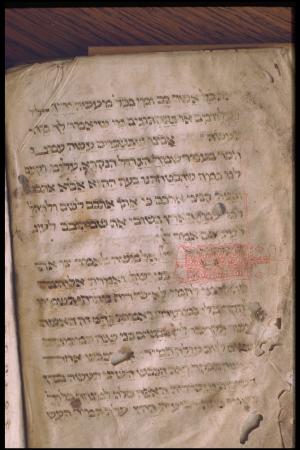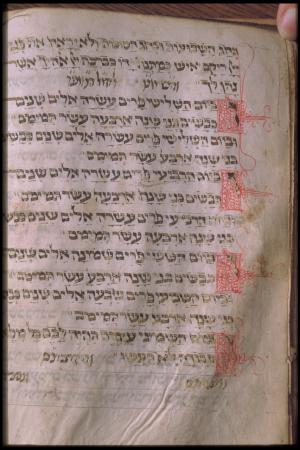Obj. ID: 1289
Hebrew Illuminated Manuscripts Austrian Siddur, Austria, 1375-1400

The present manuscript is a siddur of the Ashkenazi rite for the entire year. It includes the Passover Haggadah and the Ethics of the Fathers. It was not completed, since part of the Hosha'anot and the service for Shemini Azeret are missing. Its main text was copied by one main scribe (Scribe 1) until fol. 90v, while from fol. 91 onward four additional hands copied the text, though using similar codicological features (parchment, ruling, pricking). Effaced or missing text by Scribe 1 were completed by Scribe 6 (see: Script). At the end of the manuscript, two folios were added in a later period: fol. 119v contains part of the Kapparot service in semi-cursive Ashkenazi script, while fol. 120 is a fragment of a Torah reading: Isaiah 35: 7-10, written in different Ashkenazi scripts. They were possibly added as fly-leaves in the restoration of the binding, after 1471, as indicated in the inscription on the front cover of the binding (see: Binding).
The manuscript was decorated only in the original part copied by the main Scribe 1 (fols. 5-90v), while from fol. 83v onwards it is not decorated.
The decoration program consists of many red pen-work initial word panels or initial letters placed at the beginning of the text column for many of the main sections of the prayer. The style of the pen-work decoration of the initial letters and words recalls that of the filigree initial word panels rendered by one of the artists in the Sefer Mordecai held in Budapest (Budapest, Szèchènyi Nationalbibliotheck, Cod. Hebr. 1, commentary to the Talmud by Mordecai ben Hillel ha-Cohen). This manuscript was copied for R. Israel ben Aaron in the year 1373/74 (see: colophon on fol. 337), and the style of its decoration, which is more elaborate and varied than the Vienna Siddur, is attributed by Fingernagel to a workshop of manuscript illumination active in Vienna in the 1370’s (see: Fingernagel, “Neue Zeugen des Niederösterreichischen Randleistenstils”). The artist of the Vienna Siddur is the same as the one who painted some of the less accurate panels of the Budapest manuscript (see: for example fol. 191v and 199; Fingernagel, figs. 4-5, p. 30). He is identified mostly for dog’s heads (e.g. fols. 6v, 55v) and human faces in profile (e.g. fols. 5v, 37), and the round ending of the flourishes in the margins, sometimes filled with human faces in three-quarters (e.g. fol. 21, 53). These elements are typical of this artist, and appear also in the Budapest manuscript (e.g. fols. 52v, 122v, 157, 191v, 199) and in Latin manuscripts decorated in the same workshop and probably by the same hand, such as a manuscript held in Vienna, Universitätsbibliothek (Fingernagel: what is the content of this manuscript?, ms. III 506, fol. 186r), executed in Klosternburg around 1375.
Other Hebrew Illuminated manuscripts can be attributed to the same workshop, which are also characterized by same typical masks and human faces, even though they were not executed by the same hand. One is an undated copy of "Decisions by Asher ben Yehiel" held in Oxford (Bodleian Library, ms Reggio 3), whose secondary initial word panels are decorated with pen-work ornaments sometimes decorated with profile masks attached to the sides of the panel, or with flourishes that form loops enclosing sketchy faces, very similar to those in the Vienna manuscript. Another manuscript decorated with the same motifs is “Kizzur Piskei ha-Rosh” by Jacob ben Asher (Vatican, BAV, Ebr. 449), which bears a divorce contract dated 1391 and indicatingVienna as place. Also in this manuscript the secondary initial word panels are decorated with filigree pen-work animated by very similar masks and dog's heads so typical of this school, and its similarity to the Vienna manuscript leads us to the conclusion that they were produced in the same workshop (compare e.g. the masks on fols. 38v and 81 of the Vatican manuscript with those e.g. on fols. 37, 53 of the Vienna manuscript; the dog's heads e.g. on fols. 9v, 38v, 81 of the Vatican manuscript with those e.g. fols. 6v, 55v of the Vienna Siddur; and again the loop-shaped faces on fol. 38v of the Vatican manuscript with that e.g. fol. 53 of the Vienna).
This manuscript, even though mutilated and not very well preserved, is a precious testimony of the production of illuminated Hebrew manuscripts in Southern Austria, by an artist that was trained in a workshop that also produced German and Latin manuscripts in the last quarter of the 14th century.
sub-set tree:
Material: Parchment 118 + 2 leaves (numerated 119 and 120). Hard to distinguish between hair and flesh sides.
Measurements
|
Full page: 192 x139 mm |
|
Text space: 145 x95 mm |
Scribes
A: Original manuscript:
Scribe 1: fols. 5-90v
Scribe 2: fols. 91-94v
Scribe 3: fols. 95-96
Scribe 4: fols. 96v-111
Scribe 5: fols. 111v-118v
B: Scribe 6: a later scribe that overwrote the script of Scribe 1, which was effaced or mutilated in many places. Scribe 6 sometimes added a leaf or piece of parchment with corrected/completing text. His additional leaves or pieces of parchment are different than that used by Scribe 1 (original manuscript): the parchment is lighter. See fols. 1-3v (fol. 4 is blank) and fols. 9-9v (single leaf), and fols. 8-8v (same script).
Scribe 6 overwrites Scribe 1's effaced text e.g. on fols. 5, 7v, 8, 10, 11, 21v. 22, 23v, 26, 28v, 29, 32v, 33.
Script
|
The main text is written in square Ashkenazi script in brown ink. |
|
Instructions are written in semi-cursive Ashkenazi script of Gothic type (e.g. fols. 37v, 52-54v, 55v, 87, 111v) |
|
Some prayers and the preliminary instructions and passages for the Passover Seder are written in the same semi-cursive Gothic script (e.g. fols. 20v, 25, 28, 31, 36, 49v, 62-62v, 104). |
Columns
The main text is written in one single column.
Number of lines
|
Main text written: |
mostly in 17-19 lines, except for: quire I (by Scribe 6, fols. 1-3v) in 20 lines, single leaf 9-9v in 19 lines. |
Ruling
By plummet, 19-20 horizontal and 1 + 2+ 1 vertical lines per page. The vertical lines are ruled the full height of the page.
Pricking
Pricking is discernable in upper, lower and outer margins. In inner margins, discernable only on fols. 62-73v (quire VIII).
Quires
14 quires of varying number of leaves each: I4 (fols. 1-4v; the text in the first three folios is by Scribe 6); II(6-2)+1 (fols. 5-8v; the two first folios are missing; fol. 9 is a single added leaf), written by Scribe 6; III8 (fols. 10-17v); IV8 (fols. 18-25v); V-IX12; X6; XI-XII10; XIII8-1; XIV1+1 (2 different leaves each of different parchment and text, later bound with the ms, as fly leaves).
Catchwords
5 vertical catchwords (fols. 17v, 25v, 49v, 85v) and 2 horizontal catchwords (fols. 91v, 111v); catchword on fol. 25v is decorated with pen decoration in brown ink.
Hebrew numeration
None
Blank leaves
Fols. 4-4v, 61v, 119, 120v.
The front and the back cover of the binding are on two wooden boards. The spine has three double cords about4 cmapart, and head and tail bands made of rope. The back cover still retains most of its monastic binding made of dark brown calf-leather, decorated with an impressed rope motif frame, crossed with diagonal fillets and groups of dots arranged as flowers. There were five bossed nails along the fore edge of which two survive as well as one in the centre. The imprint of a clasp is visible in the centre fore edge.
The binding was renovated before the inscription "Mss Seb. Teng. N. 30" on the top board, by the prefect of the Hoffbibliothek Sebastian Tengnagel (active between 1606-1638). In the renovation the front board, spine and part of the back board (strip of35 mm), were covered with off-white pigskin.
A fragment of Isaiah, also bearing later inscriptions (see: History), shows paste marks which suggest that it was a paste-down. Apparently it served as a flyleaf to the original binding, for its verso is inscribed with other provationes pennae [ואלה ש]. Some of these letters resemble those inscribed on the remains of the original front paste-down (ואלה ש), which now strengthens the renovated pigskin. It is a fragment of a German manuscript/document, bearing the date 1471. It seems that another strip of this paste-down was glued with its German script facing downwards onto the back cover. It is inscribed with some later Yiddish and Hebrew inscriptions
Some first words are decorated with red pen-work club motif flourishes; some delineating human faces and dog heads in profile.
The decoration was made by one artist.
- I. Many decorated initial word panel and initial letters: for main sections of the text in red filigree pen-work (e.g. fols. 5, 25v, 31, 32, 32v, 33, 34v, 35, 37, 50v, 51, 53, 55, 55v, 69, 72, 73, 74, 78, 79v) which in some places have attached to the side of the panel: human faces (e.g. 5v, 32v, 33, 37, 37v, 53, 55, 70), dog faces (e.g.: 6v, 54, 55v, 62) and a fish (fol. 8v). Sometimes the figures have protruding tongues (e.g. fols. 5v). Sometimes, loop-shaped edges of the flourishes in the margins are animated with human faces in three-quarters (e.g.: fols. 5v, 20v, 21, 53).
- II. One decorated catchword: on fol. 25v, pen-drawing in brown ink.










